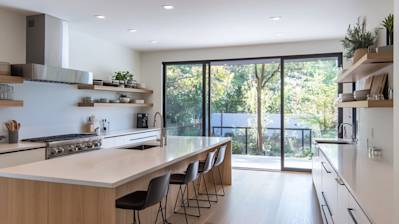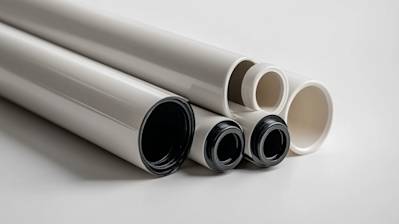Welcome to an insightful exploration of the world of new construction plumbing. In the realm of modern construction, plumbing is not just about pipes and fixtures; it's about creating efficient, safe, and sustainable systems that stand the test of time. In this comprehensive guide, we delve into the essential aspects of new construction plumbing, uncovering the crucial considerations, techniques, and technologies that shape the plumbing landscape in Lexington.
Introduction to New Construction Plumbing
What is New Construction Plumbing and Its Importance
New construction plumbing refers to the intricate network of pipes, fixtures, and systems that are meticulously installed within the framework of a freshly constructed building. It's the hidden foundation that enables the functioning of faucets, toilets, showers, and more. Proper plumbing installation is vital for the health, comfort, and convenience of the occupants, as well as the overall functionality of the structure.
- Ensures reliable water supply and efficient drainage
- Contributes to the safety and hygiene of the building's occupants
- Supports various amenities such as kitchens, bathrooms, and laundry rooms
Key Considerations for Plumbing in New Construction Projects
When embarking on a new construction plumbing project in Lexington, several key factors come into play to ensure a successful outcome:
- Collaboration with Architects and Engineers: Plumbing plans should be integrated into the overall building design to optimize layout and functionality.
- Compliance with Local Codes: Adhering to Lexington plumbing codes and regulations is paramount for safety and legality.
- Material Selection: Choosing appropriate plumbing materials that suit the building's purpose and longevity.
Planning and Designing Plumbing Systems for New Construction
Collaborating with Architects and Engineers for Optimal Plumbing Layouts
In the realm of new construction plumbing, successful collaboration between architects, engineers, and plumbing professionals is essential. Through effective communication and sharing of expertise, the optimal plumbing layout can be devised. This involves strategic placement of pipes, fixtures, and drainage systems to ensure efficient water distribution and waste disposal.
- Identifying water entry points and main distribution lines
- Strategically positioning plumbing fixtures for user convenience
- Coordinating with structural plans to avoid interference with load-bearing elements
Balancing Aesthetic and Functional Plumbing Design in New Builds
Modern construction places a significant emphasis on aesthetics alongside functionality. Plumbing systems are no exception. Achieving a harmonious balance between form and function requires careful planning and design. The integration of plumbing elements should enhance the overall architectural vision while ensuring optimal performance.
- Concealing plumbing fixtures within walls and ceilings for a clean appearance
- Using modern, sleek fixtures that complement the building's design language
- Implementing water-saving features without compromising user experience
Choosing the Right Materials for New Construction Plumbing
Evaluating Various Plumbing Materials and Their Suitability
The choice of plumbing materials greatly influences the longevity and performance of the system. In new construction plumbing, selecting the appropriate materials is crucial for preventing leaks, corrosion, and other issues. Different materials offer distinct advantages, and their selection depends on factors such as water quality, budget, and intended use.
- Copper Pipes: Known for durability and resistance to corrosion, making them suitable for both hot and cold water lines.
- PEX Tubing: Flexible and cost-effective, ideal for areas with minimal space for installation.
- Cast Iron Pipes: Often used for drainage due to their sturdy nature and noise-reducing properties.
Impact of Material Selection on Long-Term Performance and Maintenance
The chosen plumbing materials have a lasting impact on the system's maintenance requirements and overall performance. Investing in high-quality materials during the construction phase can lead to fewer repairs and replacements down the line, reducing long-term costs and inconveniences.
- Opting for corrosion-resistant materials in areas with hard water or aggressive chemicals
- Considering the environmental impact of materials and their recyclability
- Choosing materials that are compatible with various water treatment methods
Understanding Plumbing Codes and Regulations for New Builds
Navigating Local Building Codes and Permit Requirements
Lexington, like any other jurisdiction, has specific plumbing codes and regulations that dictate the standards for new construction plumbing. These codes encompass various aspects, including pipe sizing, fixture installation, and safety measures. Adhering to these codes is not only a legal obligation but also a crucial step in ensuring the safety of the building's occupants.
- Securing the necessary permits before commencing plumbing work
- Following guidelines for venting, drainage, and waste disposal systems
- Regularly updating plumbing practices to align with evolving local codes
Compliance with Plumbing Standards for Safety and Efficiency
Plumbing standards exist to promote safety, efficiency, and uniformity in plumbing practices. When engaged in new construction plumbing projects, it's essential to uphold these standards to create systems that function reliably and maintain occupant well-being.
- Installing backflow prevention devices to safeguard potable water quality
- Ensuring proper slope for drainage pipes to prevent blockages
- Following guidelines for the installation of gas lines and water heaters
Installation Techniques for New Construction Plumbing
Step-by-Step Guide to Installing Plumbing Systems in New Builds
Installing plumbing systems in new construction projects requires a systematic approach to ensure accuracy and reliability. Following a well-defined process helps prevent costly mistakes and delays, ultimately leading to a successful plumbing installation.
- Preparation: Clear the construction area and review plumbing plans.
- Pipe Installation: Lay out and secure the main pipes for water supply and drainage.
- Fixture Installation: Mount and connect fixtures such as sinks, toilets, and showers.
- Testing: Conduct pressure tests to identify leaks or weak points in the system.
- Inspection: Have the plumbing installation inspected by relevant authorities.
Dealing with Challenges in Different Types of Construction (e.g., Residential vs. Commercial)
Plumbing systems in residential and commercial new builds often present unique challenges. Residential plumbing focuses on comfort and convenience for families, while commercial plumbing must cater to higher usage demands and specific business needs.
- Residential Plumbing Challenges: Optimizing bathroom layouts, ensuring water pressure, and minimizing noise disruptions.
- Commercial Plumbing Challenges: Designing restroom facilities for high foot traffic, accommodating specialized equipment, and adhering to health and safety regulations.
Integration of Modern Plumbing Technology in New Construction
Smart Plumbing Systems and Their Benefits in New Builds
Modern technology is revolutionizing the plumbing industry, offering advanced solutions that enhance efficiency, convenience, and sustainability. Smart plumbing systems utilize sensors, automation, and remote control to provide real-time monitoring and control over various aspects of the plumbing system.
- Remote leak detection and water shut-off for preventing damage
- Smart faucets and showers that adjust water temperature and flow
- Water usage monitoring to promote conservation and reduce utility bills
Incorporating Energy-Efficient and Water-Saving Plumbing Solutions
New construction plumbing projects present an excellent opportunity to incorporate energy-efficient and water-saving solutions. By choosing eco-friendly fixtures and implementing sustainable practices, builders can contribute to environmental conservation and offer long-term benefits to the building's occupants.
- Low-flow toilets and faucets to reduce water consumption
- Energy-efficient water heaters and insulation for reduced energy waste
- Graywater systems that recycle and repurpose water for non-potable uses
Collaboration between Contractors and Plumbers in New Construction
Effective Communication and Coordination for Seamless Plumbing Installation
Smooth collaboration between contractors and plumbers is essential to ensure that plumbing installation aligns seamlessly with the overall construction plan. Open communication and mutual understanding prevent conflicts, delays, and errors that can disrupt the project's timeline and budget.
- Regular project meetings to discuss progress, challenges, and adjustments
- Sharing updated blueprints and design modifications promptly
- Addressing unforeseen issues through collaborative problem-solving
Role of Plumbers in Ensuring Plumbing Aligns with Overall Construction Plan
Plumbers play a pivotal role in making sure that plumbing installations adhere to the overarching construction plan. Their expertise ensures that pipes, fixtures, and systems are strategically placed to support the building's functionality and aesthetics.
- Ensuring proper clearance for pipes within walls, ceilings, and floors
- Coordinating with other trades to avoid interference or clashes
- Offering insights on potential plumbing-related challenges and solutions
Preventing Common Plumbing Issues in New Construction
Addressing Potential Problems Before They Arise
Prevention is the cornerstone of successful new construction plumbing. Identifying and addressing potential issues during the planning and installation stages can save significant time, money, and headaches down the road.
- Ensuring proper slope and venting to prevent drainage problems
- Double-checking pipe materials and connections to prevent leaks
- Conducting thorough pressure and flow tests before completing installation
Tips for Minimizing Leaks, Blockages, and Other Plumbing Concerns
Minimizing plumbing issues requires a combination of proper installation practices, material selection, and ongoing maintenance. By following best practices and educating occupants, many common problems can be avoided.
- Regularly cleaning and maintaining drains to prevent blockages
- Using quality materials and professional installation to prevent leaks
- Providing occupants with guidelines for proper usage and maintenance
Quality Assurance and Testing in New Construction Plumbing
Importance of Thorough Testing to Ensure Plumbing System Integrity
Before finalizing a new construction plumbing project, comprehensive testing is crucial to ensure that the system functions as intended. Rigorous testing helps identify any hidden flaws or weaknesses that could lead to problems after occupancy.
- Conducting pressure tests to identify leaks and weak points
- Testing fixture operation, water temperature, and water pressure
- Ensuring proper drainage and preventing standing water in pipes
Steps for Comprehensive Inspection and Leak Detection
Thorough inspection and leak detection are integral to plumbing quality assurance. Professional plumbers use specialized tools and techniques to identify potential leaks and ensure that the entire plumbing system is functioning optimally.
- Utilizing infrared cameras to detect hidden leaks within walls and floors
- Performing smoke tests to identify ventilation issues and pipe leaks
- Conducting dye tests to identify leaks in fixtures and drainage systems
New Construction Plumbing Maintenance and Warranties
Educating Clients on Proper Care of New Plumbing Systems
Once the plumbing system is installed, educating clients about its proper usage and maintenance is essential. Providing guidance on regular maintenance tasks and offering tips for preventing common issues can extend the lifespan of the plumbing system.
- Advising clients on avoiding harsh chemicals that can damage pipes
- Guidelines for preventing frozen pipes during cold Lexington winters
- Encouraging regular inspections to catch minor issues before they escalate
Offering Maintenance Services and Warranty Coverage for Peace of Mind
Providing maintenance services and warranty coverage can reassure clients that their plumbing system is in capable hands. Offering post-installation support helps build trust and ensures that any unexpected issues are promptly addressed.
- Regularly scheduled maintenance visits to inspect and maintain the plumbing system
- Warranty coverage for repairs and replacements in case of unexpected failures
- 24/7 emergency services to handle urgent plumbing issues
Budgeting and Cost Considerations for New Construction Plumbing
Estimating Plumbing Costs and Allocating Budget for New Builds
Accurate budgeting is crucial for any construction project, including new construction plumbing. Properly estimating costs and allocating the budget ensures that plumbing installation is aligned with the overall financial plan.
- Considering material costs, labor expenses, and permit fees
- Accounting for unexpected contingencies in the budget
- Seeking quotes from reputable plumbing contractors for accurate estimates
Balancing Quality and Affordability in Plumbing System Installation
While budget considerations are essential, it's crucial not to compromise on the quality of plumbing system installation. Balancing affordability with quality ensures that the plumbing system operates reliably and minimizes the likelihood of costly repairs in the future.
- Investing in durable materials to prevent premature replacements
- Choosing experienced plumbing contractors with a proven track record
- Seeking cost-effective solutions without sacrificing functionality and safety
Conclusion: Elevating Lexington's New Construction Plumbing Landscape
In the realm of new construction plumbing, precision, collaboration, and innovation are the cornerstones of success. As Lexington's leading plumbing partner, KYPD Service is dedicated to delivering excellence in every aspect of new construction plumbing. From meticulously planning and designing plumbing systems to embracing modern technologies and ensuring quality maintenance, we take pride in contributing to the vibrant growth and development of this dynamic city. By focusing on the finer details of plumbing, we lay the foundation for structures that stand strong and serve generations to come.
Tags: new construction plumbing,














